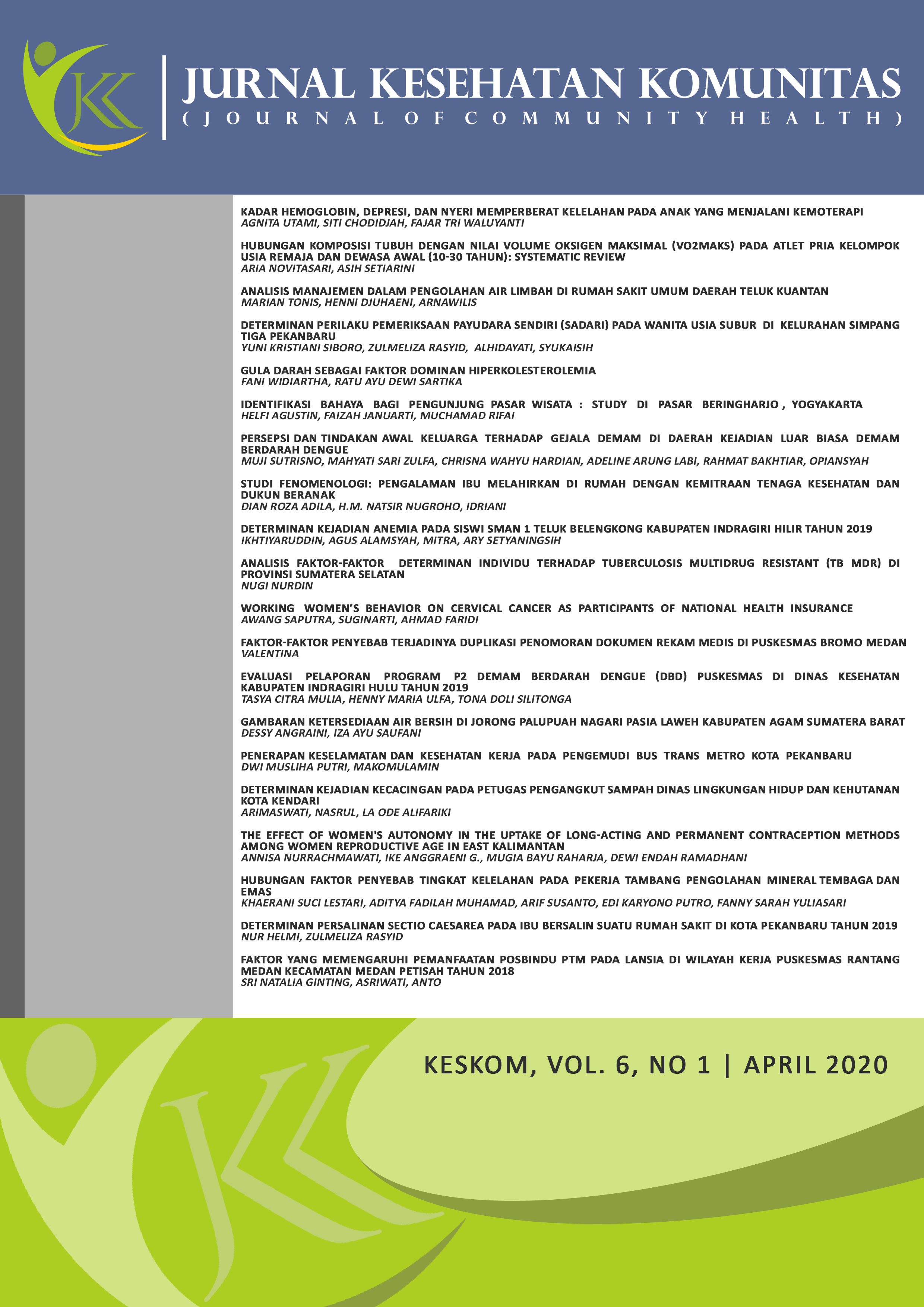Factors Affecting the Utilization of Non-infectious Diseases Posbindu on the Elderly in District of Rantang Medan Public Health Care, Petisah District 0f Medan City on 2018
DOI:
https://doi.org/10.25311/keskom.Vol6.Iss1.523Keywords:
Influencing Factors, Utilization of Posbindu PTM, ElderlyAbstract
Non-communicable diseases have become the leading cause of death globally at this time. Posbindu PTM is a form of service that involves community participation through promotive-preventive efforts. This type of research is a mixed methods approach with the aim to find out the factors that influence the utilization of Posbindu PTM in the elderly in the Work Area of ​​Rantang Medan Puskesmas Medan Petisah District with a population of 653 elderly with a sample technique using accidental sampling as many as 87 elderly. The results showed that knowledge had a sig-p 0.011 <0.05, an attitude of sig-p 0.017> 0.05, a distance of sig-p 0.041 <0.05, support of health personnel sig-p 0.415> 0.05 and family support have a p-p 0.028 <0.05. The conclusion is the influence of knowledge, attitudes, distance and family support for the use of Posbindu PTM in the elderly, while the support of health workers does not have an influence on the use of Posbindu PTM in the elderly. This research is expected to be a useful input or information for Puskesmas, Health Services, and other agencies related to the use of Posbindu PTM.
Key word : Influencing Factors, Utilization of Posbindu PTM, Elderly
Downloads
References
Shilton T, Champagne B, Blanchard C, Ibarra L, Kasesmup V. Towards a global framework for capacity building for non-communicable disease advocacy in low- and middle-income countries. Glob Health Promot. 2013;20(4_suppl):6–19.
World Health Organization. Noncumminicable Diseases Progress Monitor. 2017. 211 p.
Kemenkes RI. Hasil Utama Riskesdas Tahun 2018. Jakarta; 2018. 88 p.
Kemenkes RI. Petunjuk Teknis Pos Pembinaan Terpadu Tidak Menular (POSBINDU PTM). Jakarta: Kementerian Kesehatan Republik Indonesia; 2014.
Kemenkes RI. Profil Kesehatan Indonesia [Internet]. Ministry of Health Indonesia. 2017. 107–108 p. Available from: website: http://www.kemkes.go.id
Stanley M, Beare PG. Buku Ajar Keperawatan Gerontik. 2nd ed. Jakarta: EGC; 2007.
Handayani DE. Pemanfaatan Pos Pembinaan Terpadu Oleh Lanjut Usia Di Kecamatan Ciomas Kabupaten Bogor. Thesis. Universitas Indonesia; 2012.
Ulin PR E a. Qualitative Methods In Public Health. Amerika: Jossey Bass; 2005.
Septriliyana RN, Sar WE. Hubungan Pengetahuan dengan Sikap Lansia Mengenai Posbindu di RW 07 Desa Kertawangi Kecamatan Cisarua Kabupaten Bandung Barat. J Kesehat Kartika. 2011;14(31):43–9.
Notoatmodjo S. Promosi Kesehatan dan Perilaku Kesehatan. Revisi. Jakarta: Rineka Cipta; 2014.
Deri P. Faktor yang Berhubungan dengan Pemanfaatan Posyandu Lansia di Wilayah Kerja Puskesmas Sikapak Kota Pariaman. Padang: Skripsi Universitas Andalas; 2015.
Wahyuni DN. Faktor-Faktor yang Berhubungan dengan Kunjungan Pos Pembinaan Terpadu (Posbindu) pada Lansia di Wilayah Kerja Puskesmas Ciputat. Jakarta: Skripsi Universitas Islam Negeri (UIN) Syarif Hidayatullah; 2017.
Sulistyorini. Posyandu dan Desa Siaga. Yogyakarta: Nuha Medika; 2010.
Ratna SDW, Mieke S. Faktor-Faktor yang Berhubungan dengan Pemanfaatan Posbindu Penyakit Tidak Menular (PTM) di Wilayah Kerja Puskesmas Kecamatan Setiabudi Kota Jakarta Selatan. J Kebijak Kesehat Indones JKKI. 2018;07(02):49–56.
Kemenkes RI. Undang-undang Republik Indonesia Tentang Tenaga Kesehatan No 36 tahun 2014. 2014;(1):1–26.
Lestari I, Hartati E, Galuh M. Faktor-Faktor yang Mempengaruhi Minat Kunjungan Remaja Ke Posbindu di Wilayah Tlogosari Kulon RW 16 Kota Semarang. 2017;1–7.
Intarti dkk WD. Faktor-Faktor yang Mempengaruhi Pemanfaatan Posyandu Lansia. J Heal Stud. 2018;2(1):110–22.

Downloads
Submitted
Accepted
Published
How to Cite
Issue
Section
License
Copyright (c) 2020 Jurnal Kesehatan Komunitas

This work is licensed under a Creative Commons Attribution-NonCommercial-ShareAlike 4.0 International License.
Copyright @2017. This is an open-access article distributed under the terms of the Creative Commons Attribution-NonCommercial-ShareAlike 4.0 International License (http://creativecommons.org/licenses/by-nc-sa/4.0/) which permits unrestricted non-commercial used, distribution and reproduction in any medium











































